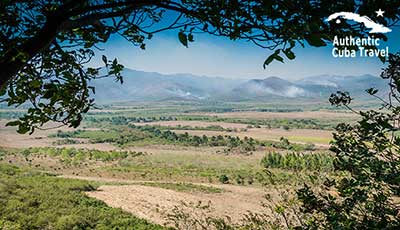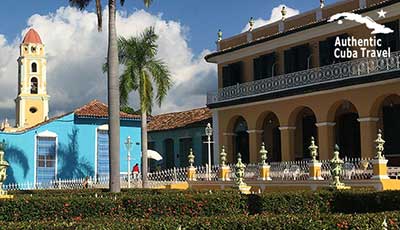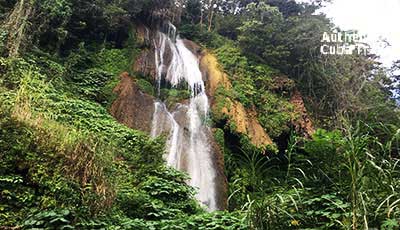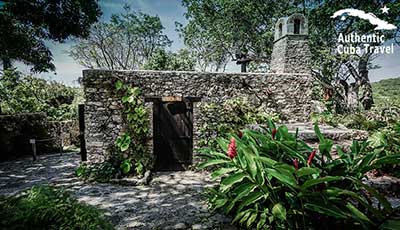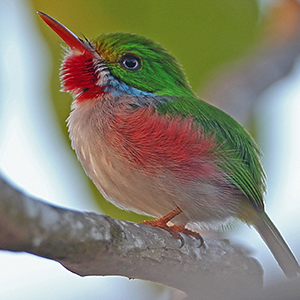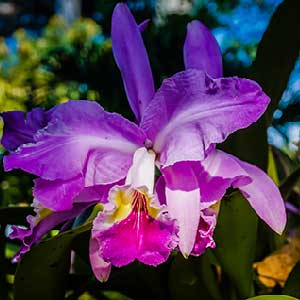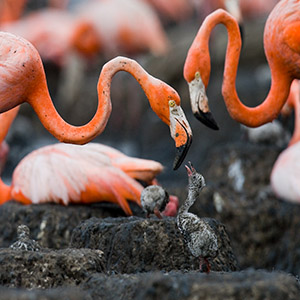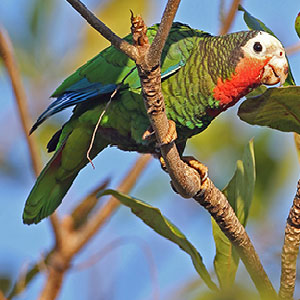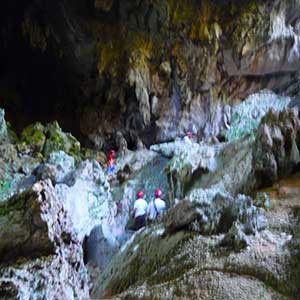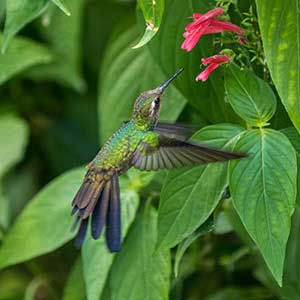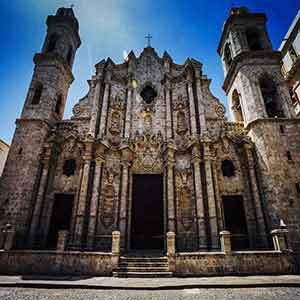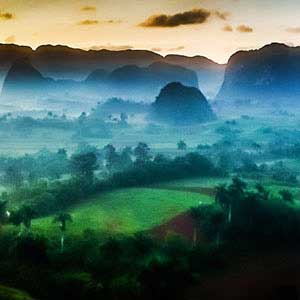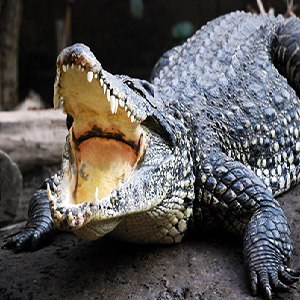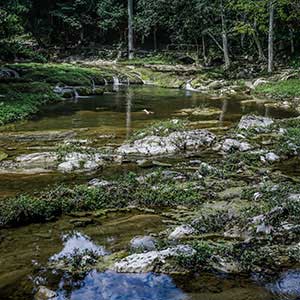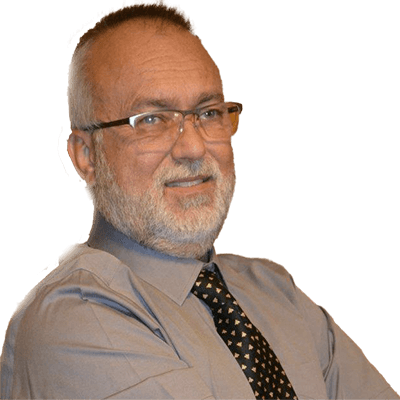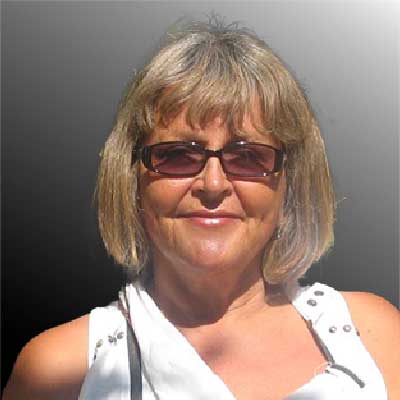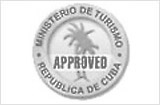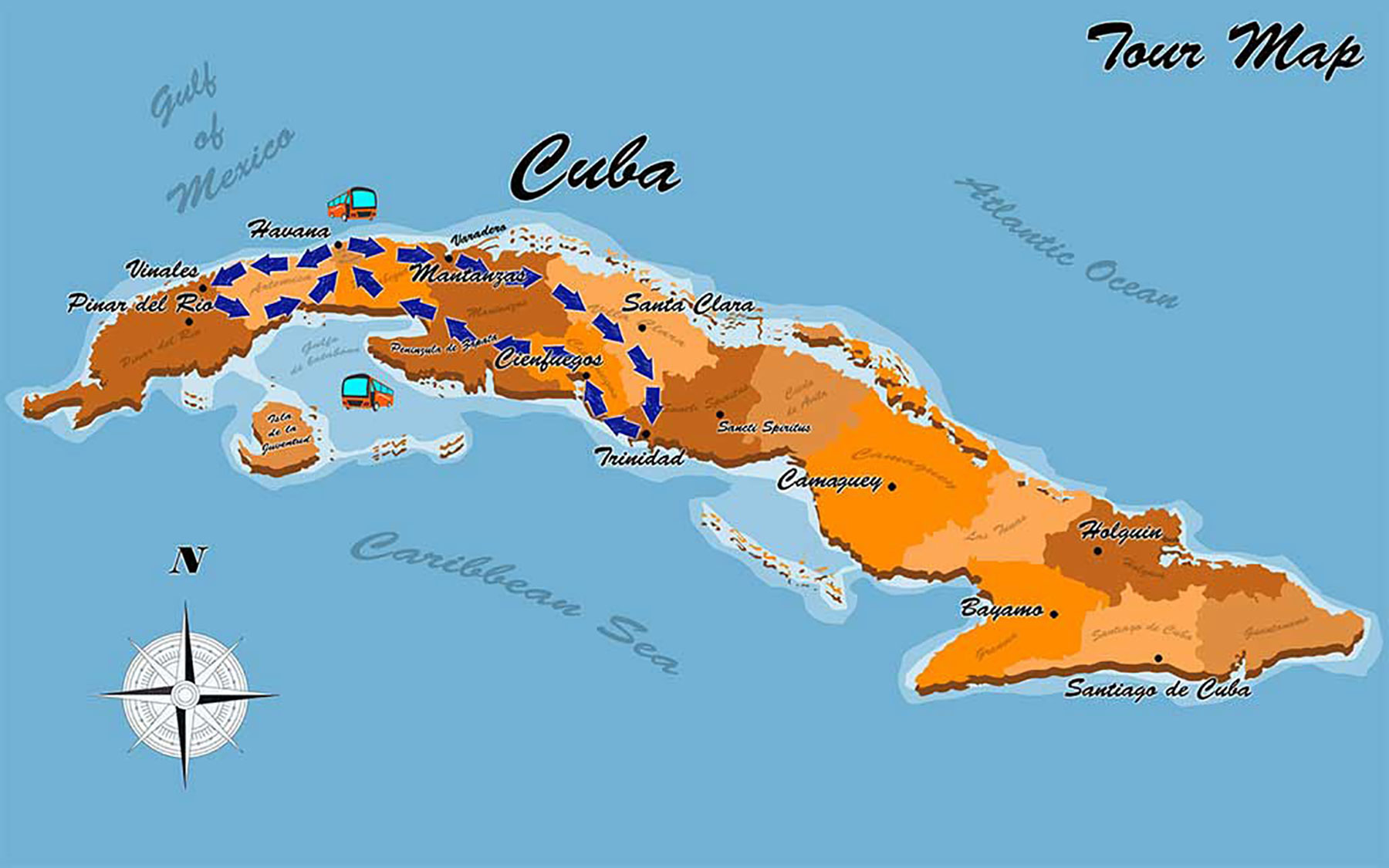Travel to 4 Cuba’s UNESCO Biosphere Reserves!
Cuba Nature Tours & Travel for Ornithologists, Wildlife Biologists, Forestry Professionals, Ornithology Curators, Zoology Educators; and other Environmental Science Enthusiasts.
From May 1 to May 10, 2026
Travel to 4 UNESCO Biosphere Reserves: Peninsula de Zapata, Buenavista, Guanahacabibes, and Sierra del Rosario! Plus Cuba's Premier National Parks and Protected Areas! $2,999 (all taxes included)!
Referral Discount: $100
And remember every person you invite will also receive a $100 discount!
Working under the auspices of Cuba’s foremost environmentalist and nature conservation organizations, the Long Point UNESCO Biosphere Reserve of Canada and Authentic Cuba Travel® has gained access to the most pristine natural Cuban sites of this tropical paradise, from UNESCO Biosphere Reserves and National Parks to Protected Areas, and invite nature lovers, bird watchers, naturalist, biologists, environmentalists and nature conservationist to witness the great biodiversity of the largest and most unspoiled island in the Greater Antilles.
This official Cuba nature tour of Cuba's Protected Areas captures the Cuban natural beauty and biodiversity of flora and fauna that defines the island as a unique Caribbean destination for eco tourism. As you travel through the UNESCO Biosphere Reserves, national parks and protected areas, you will interact with local communities, ornithologists, scientists and naturalists, and enjoy cross cultural/ people-to-people experiences that will remain with you for the rest of your life.
You will be fascinated by the
Cuban people, the
culture of Cuba, and the social/political/economic structure of Cuba. Cuba is a relatively poor, developing country with 2% of the Latin American population that somehow manages to produce 11% of its scientists!
Cuba is home to some of the most unusual creatures on earth, including the feisty Cuban crocodile, the world’s smallest bird and frog, and migrating land crabs.
Please, check the day-by-day
below
Take A Sneak Peak at the Cuban Destinations You Will Visit Outside Havana
Cuba Engage Tours
Notice to US Wildlife Environmental and Conservation Organizations, US Bird Conservancy Organizations, and other Environmental Organizations from USA:
US Wildlife Environmental and Conservation Organizations, US Bird Conservancy Organizations, and other Environmental Organizations from USA can organize a trip to Cuba under the provisions of the General License for Educational Activities, the General License for Support for the Cuban People, the General License for Group People-to-people Educational Travel and other Academic Educational Activities, the General License for Professional Research, the General License for Semi-Professional & Amateur International Sports Competition, the General License for Humanitarian Projects, the General License for Activities of Private Foundations or Research or Educational Institutes among others. Certain conditions are to be met to comply with OFAC General License requirements for each category of USA Cuba travel though.
The mission of your organization and the objective of your trip to Cuba determine under what general license you can travel to Cuba legally. In general, most trips should consist of a full-time schedule of activities intended to promote the exchange with the ordinary citizens of Cuba. This full-time schedule must also include educational activities that result in meaningful interaction in between U.S and Cuban nationals. Free time in excess or regular tourists' activities are not permitted.
We take care of all details both in North America and in Cuba, including VISA and flight arrangements to Cuba's main destinations via USA ports (Miami, Tampa, Fort Lauderdale, Houston, New York, Los Angeles, and others) or through third countries like Canada and Mexico. Authorized US organizations can travel through a third country subject to the same restrictions and requirements as those flying directly from USA.
At Authentic Cuba Travel®, we have been organizing such educational and cultural travel experiences from the United States of America for years with great success.
Notice to US Conservation Universities, Colleges and Schools with Forestry and Wildlife, Marine Ecosystems, Fisheries Ecology and Environmental Conservation Departments and Programs:
In January 2016, the US Government announced further enhancements to the 12 categories of authorized travel to Cuba that previously required a specific license (this is, lengthy applications to OFAC). Now travel to the Caribbean island is allowed under a general license (this is, self-completed paperwork with no application to OFAC needed).
After President Trump's policy change on USA Cuba travel on February 6, 2025, and July 14, 2025, the General License for Educational Activities remains in place. Accredited U.S. graduate or under graduate degree-granting institutions; U.S. Academic Institutions; and U.S. Schools can organize and sponsor an educational trip to Cuba for their students, faculty and staff under the General License for Educational Activities, provided that the trip meets OFAC guidelines; and that an employee or other representative of the organization escorts the trip to make sure such guidelines are followed by all participants.
US Conservation Universities, Colleges and Schools with Forestry and Wildlife, Marine Ecosystems, Fisheries Ecology and Environmental Conservation Departments and Programs; and other Academic Institutions from USA can organize and sponsor a trip to Cuba for educational activities. The purpose of the Cuba travel should be for:
_ the participation in a structured educational program offered for credit as part of a course of the sponsoring institution;
_ educational exchanges sponsored by Cuban or U.S. secondary schools involving secondary school students’ participation in a formal course of study or in a structured educational program offered by a secondary school or other academic institution, and led by a teacher or other secondary school official are authorized. This authorization allows for participation of a reasonable number of adult chaperones to accompany the secondary school students to Cuba.
_ attendance at non-commercial academic seminars, conferences and workshops related to Cuba sponsored or co-sponsored by U.S. academic institution.
_ non- commercial academic research related to Cuba for the purpose of obtaining a graduate or undergraduate degree;
_ the participation in a formal course of study at a Cuban academic institution provided that credits will be accepted toward the student’s graduate or undergraduate degree.
We take care of all details both in North America and in Cuba, including VISA and flight arrangements to Cuba's main destinations via USA ports (Miami, Tampa, Fort Lauderdale, Houston, New York, Los Angeles, and others) or through third countries like Canada and Mexico. Authorized US organizations can travel through a third country subject to the same restrictions and requirements as those flying directly from USA.
At Authentic Cuba Travel®, we have been organizing such educational and cultural travel experiences from the United States of America for years with great success.
Want to Take Your Students to Cuba?
Authentic Cuba Travel® operates courses, programs and exchanges sponsored by Cuba’s top educational schools and organizations such as the University of Havana, Cuba's National Ballet School, Cuba's Sports Ministry, San Alejandro’s Arts School, Insituto Cubano de La Musica, Conjunto Folklórico Nacional de Cuba. Request custom-made no-obligation Cuba Study Tours® for your students and check all the resources we put at your service. Do not wait any longer. Now is the time to start planning the next Cuba tour for your students.
Cuba Study Trips
-
Cuba Business Tours & Travel
Explore Cuba's Economy and Private Business Sector
-
Cuba Healthcare Tours & Travel
Professional Research Cuba's Medical System & Healthcare Model
-
Cuba Cultural Tours & Travel
Discover the Wonders of Cuba’s UNESCO World Heritage Sites
-
Cuba Nature Tours & Travel
Visit UNESCO Biosphere Reserves, National Parks & Protected Areas
-
Cuba Architecture Tours & Travel
Explore America’s largest & best preserved Spanish Historical Cities
-
Cuba Catholic Tours & Travel
Exchange with Cubans at Cathedrals, Churches & Social Projects
Cuba School Programs
-
Spanish Immersion Course
Spanish Course sponsored by the University of Havana
-
Ballet Training Course
Ballet Course sponsored by Cuba's National Ballet School
-
Sports Training Exchange
Sports Trainning sponsored by Cuba's Sports Ministry
-
Arts Educational Program
Arts Program sponsored by San Alejandro’s Arts School
-
Jazz Performance
Sponsored by the Havana Jazz Festival’s Organizing Committee
-
Dance Workshops
Sponsored by Conjunto Folklórico Nacional de Cuba
Cuba Education Tours
Cuba Real Tours
Cuba's Nature
Among the large mammal species, the protected Antillean manatee is reproduced in more than 20 breeding groups, in the Ciénaga de Zapata and Villa Clara.
What's Included?
- Meet with directors of Cuba's UNESCO Biosphere Reserves.
- Tour UNESCO Biosphere Reserve, Peninsula de Zapata.
- Travel to UNESCO Biosphere Reserve, Buenavista.
- Explore UNESCO Biosphere Reserve, Guanahacabibes.
- Travel to UNESCO Biosphere Reserve, Sierra del Rosario.
- UNESCO World Cultural Landscape Heritage Site, Vinales Valley.
- Explore the Santo Tomas Cave in Vinales Valley.
- Bird Watching exploration in Las Salinas Wildlife Refuge.
- Travel to Topes de Collantes National Park.
- Travel to Caguanes National Park.
- Travel to Cayo Santa Maria National Park.
- Visit to Guama Crocodile Breeding Farm.
- Guided tour of UNESCO Heritage Site, Havana Historical Centre.
- Guided tour of UNESCO World Heritage Site, Trinidad.
Cuba Tour Itinerary
-
Day 1. Friday 1 May 2025. Hello Cuba Arrival at Santa Clara International Airport.
Meet your Cuban tour guide and bus driver.
Private transfer to Havana City.
Check in at your hotel Habana Libre Hotel located at the cultural center of Havana City.
Group check-in.
Breakfast is complimentary from 7:00 a.m. to 10:00 a.m.
Cuba is renowned for its exceptional biodiversity. Its ecosystems are among the richest and best preserved in the Caribbean. Cuba boasts more than 84 protected areas, making up almost 14% of the lands and 16% of the shelf, along with 6 UNESCO Biosphere Reserves. Its flora is abundant and varied; it is estimated that the 110,992-square-kilometre archipelago contains almost 4% of all the world’s plant life.
-
Day 2. Saturday 2 May 2025. Havana Morning: meeting with representatives of Cuba’s National Center for Protected Areas (CNAP). The Center, created in 1995 by the Ministry of Science, Technology and Environment, is responsible for the management of Cuba's National System of Protected Areas. With a network of 15 provincial environmental groups, CNAP is the maximum authority responsible for conservation in Cuba. CNAP also has experience implementing conservationist projects with international funding such as UNEP-GEF, WWF Canada and CIDA.
Lunch at La Mina restaurant.
Afternoon: guided walking tour of Old Havana, UNESCO World Heritage Site.
Visit to Square of Arms, ancient military parade ground for Spanish soldiers and surrounded by impressive buildings such as:
Palacio de los Capitanes Generales was the former seat of colonial government. Today the building houses the Museum of the City.
Palacio del Segundo Cabo, the seat of the second authority of the island.
Castillo de la Real Fuerza. The second oldest fortress built by the Spaniards in the West Indies. The castle was recently renovated and reopened in June 2008 to hold the impressive maritime museum. Well laid out exhibits chart Spain and Cuba's naval history.
Visit to San Francisco Square, one of the oldest in the historical quarter.
Visit to Plaza Vieja, the only civic square of colonial times. Notice it doesn't have a church or government building around. Here we will visit important institution for visual arts.
Visit to the Cathedral Square, the most beautiful and private 18th century colonial plaza of Cuba, named after the masterpiece of Cuban baroque architecture: the Cathedral of Havana built by the Jesuit order.
Free time in the famous handicraft market of Old Havana where you can purchase all sorts of crafts and souvenirs by local artisans.
Evening: tonight we have a Cuban band playing for us! You'll learn to dance to Salsa, Son, Rumba, and other popular Cuban rhythms with instruction from bandleaders. -
Day 3. Sunday 3 May 2025. UNESCO Biosphere Reserve, Guanahacabibes Morning: early transfer to Maria la Gorda at the UNESCO Biosphere Reserve Peninsula de Guanahacabibes.
The Guanahacabibes National Park is one of the country's largest natural reserves. It is separated from the rest of the island by white sand plains where one of Cuba's largest lakeside areas lies. A relatively small area holds some 100 lakes, as well as the largest and purest fields of silica sand, which is 99.8% pure.
Nature tourism is a major attraction since the area is inhabited by 172 species of birds belonging to 42 families, 11 of which are endemic and 84 are migratory.
Experts also believe that 4 of the 7 species of marine turtles living on the planet have survived in the Guanahacabibes Peninsula. The coastline also contains preserved coral reefs, with the northern coast being lined by the cays and isles of the western Colorados Archipelago.
Check in and lunch at Maria La Gorda resort.
Afternoon: free so that you embark on your favourite natural expeditions. Worth mentioning:
- Trails such as Las Perlas Cave, Forest Facing the Sea, Guanahacabibes before Columbus, La Majagua and Hoyo del Palmar.
- Birds watching spots such as Currents Cape, La Bajada, El Bosque, Hoyo del Palmar and Herbazal de Cienaga.
- Scuba diving. Maria la Gorda offer 39 diving sites of high level diving, some are still not named, all of them are less than hour cruise, some at even a few minutes away.
-
Day 4. Monday 4 May 2025. UNESCO World Heritage Site, Vinales Morning: transfer to Vinales Valley in Sierra de los Organos mountain range, declared as a World Heritage Site by UNESCO in 1999, in the category of Cultural Landscape. Among the reasons listed is the following: "The Vinales Valley is an outstanding, calcic landscape in which the traditional agricultural methods (particularly the tobacco harvest) have been preserved without alteration for centuries. A rich vernacular tradition is preserved as well in the region in terms of architecture, handcraft and music".
Over arrival visit to Cueva de Santo Tomas, Cuba's largest cave system. The cave is spectacular, especially where the roof has collapsed and you walk into a green jungle paradise sunk into a mountaintop. Several cave rooms are connected over an area of 45 kilometers in length, extend over seven levels. The rooms bear names such as "Salón del Caos" (Chaos Saloon), "Increíble" (incredible) or "Tinieblas" (darkness). Solid footwear and clothing are recommended.
Lunch at El Mural de La Prehistoria.
Afternoon: exploration of Viñales Valley containing the most spectacular scenery in Cuba and some of the most interesting and varied geological formations on the island. The valley is particularly famous for its great freestanding rock formations called mogotes.
Meet with local farmers that have been passing from generation to generation the secrets of growing the best tobacco in the world.
Visit to Mural de la Prehistoria, a huge painting on the side of a Mogote.
Explore Viñales town at your leisure: its open-air craft market, Parque Marti, town church, and other interesting sites of this charming colonial hamlet.
Visit Carmen and Caridad Miranda’s botanical garden, called the Viñales Botanical Garden. The two widows maintain a garden full of fruits, orchids and medicinal plants.
Check in at Los Jazmines hotel. Time to relax by the swimming pool! -
Day 5. Tuesday 5 May 2025. UNESCO Biosphere Reserve, Sierra del Rosario Morning: check out your hotel and transfer to Las Terrazas eco-community in Sierra del Rosario, first UNESCO Biosphere Reserve in Cuba.
Four rivers run through the evergreen and semi-deciduous tropical forest of Sierra del Rosario, natural habitat to one of the world's smallest frogs and more than 115 bird species including a large number of migratory birds that nest in Cuba’s tropical climate.
Group welcome by Dr. Maritza Garcia, Director of the Sierra del Rosario Biosphere Reserve. We’ll exchange with the environmental scientists and technicians responsible for the restoration of the jungles and forests of Las Terrazas to learn the principles, approaches and practices that combined serve to sustain the region.
Later we visit the ruins of a French Coffee Plantation built in 1801 where we will have lunch.
As we explore the area, we can spot birds such as the Cuban Trogon (Priotelus temnurus), the national bird of Cuba, Red-legged Honeycreeper (Cyanerpes cyaneus), Gundlachs hawk (Accipiter gundlachi) and others.
Mid-afternoon: transfer to Peninsula de Zapata National Park, declared UNESCO Biosphere Reserve and Ramsar Site, located in the southern coast of the island.
It covers an area of 5000 square kilometres of woods and seacoast vegetation, marsh and mangroves. The park is the natural home to over 160 bird species and 900 varieties of higher plant families. It is also a favourite stop for tens of thousands of migratory birds!
This is the habitat of endemic bird species such as the Zapata Rail (Cyanolimnas cerverai), the Zapata Wren (Ferminia cerverai) and Zapata Sparrow (Torreornis inexpectata). The swamp is also the natural habitat of the Cuban Crocodile (Crocodrylus rhombifer Cuvier), considered as a national symbol after its resemblance with the geography of the island.
Check in at Villa Playa Larga. Dinner at hotel -
Day 6. Wednesday 6 May 2025. UNESCO Biosphere Reserve, Peninsula de Zapata Early morning expedition to Las Salinas Wildlife Refuge, unique Cuban site for birdwatching where two continental corridors of migratory birds coincide.
We will be looking for the Roseate Flamingo (Phoenicopterus ruber), Sand hill Crane (Grus canadensis), Yellow-headed Warbler (Teretistris fernandinae), Spoonbill (Ajaia ajaja), Clapper Rail (Rallus longirostris), Common Black Hawk (Buteogallus anthracinus) and others.
Visit to La Boca and Guama Ceramic Workshop.
12:30 p.m. Lunch at La Boca restaurant.
Afternoon: meet with Dr. Jorge L Jiménez, Director of the Zapata Swamp Biosphere Reserve, to learn about their conservation work in the area and the challenges they face today.
UNESCO Biosphere Reserve, Peninsula de Zapata, is the largest protected area in the Caribbean. There are numerous areas designated for environmental conservation, such as the Zapata Swamp Natural Reserve and Las Salinas Wildlife Refuge.
The swamp is not only known for its size but also for being the best preserved wetlands in all of the Antilles, designated as a "Wetland of International Importance" by the Ramsar Convention on Wetlands in 1971.
Visit to Guama Crocodile Breeding Farm, that has successfully bred one of the largest reptiles of Cuba since 1974. The Cuban Crocodile (Crocodrylus rhombifer Cuvier) is considered an endangered species that can be found at the Zapata Swamps and Lanier Swamps only. The Cuban Crocodile (Crocodrylus rhombifer Cuvier) is one of the two most aggressive species of crocodiles in the world and endemic to Cuba.
Late afternoon: transfer to Trinidad City. Check in at all-inclusive Trinidad del Mar beach resort. You'll have time for dinner and a swim in the warm waters of the Caribbean Sea. -
Day 7. Thursday 7 May 2025. Topes de Collantes National Park Morning: we will board former Russian army trucks for Topes de Collantes in the Escambray Mountain Range, Cuba's second highest mountain range- reaching 3,700 feet atop Pico San Juan. The mountains are home to small mountain villages and are a delight for birders and walkers alike. Slopes are swathed in Caribbean pines, ancient tree ferns, bamboo, and eucalyptus.
Arrival at Hacienda Codina, an old Spanish Hacienda, once part of a large Spanish coffee plantation where we will have a typical lunch. Followed by a walk around this area to admire the beauty of the surrounding landscape.
Topes de Collantes National Park in the Escambray mountains in Central Cuba, a perfect place for encountering the Cuban Emerald (Chlorostilbon ricordii), Broad-winged Hawk (Buteo platypterus), Cuban Parrot (Amazono leucocephala), Fernandina’s Flicker (Colaptes fernandinae) and many others.
Afternoon: guided walking tour of UNESCO World Heritage Site, Trinidad’s Historical Center, a perfect relic of the early days of the Spanish colony with beautifully preserved streets and buildings with hardly a trace of the 20th century anywhere.
We will stop at a mirador (lookout) over the Sugar Mill Valley, where the sugar barons used to have their countryside mansions and mills. This site is an UNESCO World Heritage Site.
Trinidad is well known for its pottery makers. We meet with a family that has been passing the tradition for generations: the Santanders.
-
Day 8. Friday 8 May 2025. Buenavista Biosphere Reserve- Caguanes National Park Morning: departure to Caguanes National Park in UNESCO Biosphere Reserve, Buenavista.
The Buenavista Biosphere Reserve is situated on the northern coast of Cuba, in parts of the Villa Clara, Sancti Spiritus and Ciego de Avila provinces, covering a total surface area of 313,502 hectares. The Buenavista Biosphere Reserve has eleven core areas in two National Parks: Caguanes and Santa Maria Key. Other ecological reserves are established on Cayo Francés, Cayo Santa María, Cayo Guillermo and Cayo Coco, while a fauna reserve is set up on Cayo Las Loras.
Caguanes National Park, in north-central Cuba contains marine, land and swampy areas, with a wealth of well-preserved natural attractions suited for nature lovers and bird watchers alike! Its cave system has over 35 grottoes and caves, which contain the largest expressions of rupestrian art in central Cuba.
One of the singular features of this national park is the group of stone formations called Piedras Cays, which are surrounded by the sea and have coastal cliffs, natural arches and sea niches that serve as refuges for many species of flora and fauna.
En route, we will meet with Ernesto Pulido, director of Buenavista of UNESCO Biosphere Reserve, in its offices in Sancti Spiritus.
Check in at all inclusive Cayo Santa Maria Beach Resort, located in Cayo Santa Maria Key, a small 13 km long island located in the province of Villa Clara. -
Day 9. Saturday 9 May 2025. Buenavista Biosphere Reserve- Caguanes National Park Enjoy a day of relaxation and adventure.
Laze on secluded sandy beaches. Slip on a snorkel and flippers and head out into sparkling waters to glimpse rainbow fish and coral. Or pull on your hiking boots and keep your eyes peeled for rare birds, lizards and other native animals.
Here, life is all about making the most of the UNESCO Biosphere Reserve’s natural beauty. There’s a sugar-white sandy beach that stretches for 13 kilometres, the whole island is a bird-watcher’s dream, and there’s just a smattering of shops. -
Day 10. Sunday 10 May 2025. Departure Early morning departure to Santa Clara City International Airport for departure.
Expert’s Corner
Hello! I’m Bernt Dietmar. Over 20 years ago, I visited Cuba as part of a delegation of American scientists interested in exploring opportunities for research and business collaboration. I was surprised by Cuba’s high academic standards, and the methods used in the educational system. We founded Authentic Cuba Travel® to show that Cuba is more than another Caribbean tourism destination and promote the understanding in between Cuba and North America. I kindly invite you to join us. We'll explore UNESCO World Heritage Sites, exchange with Cubans, partake in local food dishes, music, rum, and much more!
Cuban Festivals
Every year Cuba’s International Festivals brought travellers to Cuba from all over the world. Every year Authentic Cuba Travel® makes sure that those attending international events such as the Havana Jazz Festival, the Havana Book Fair, the Havana Film Festival, the Havana Art Biennial, the Fire Festival, the Havana Ballet Festival or the Habano Cigar Festival get the most out of their Cuba travel experience and get to know the authentic Cuba.
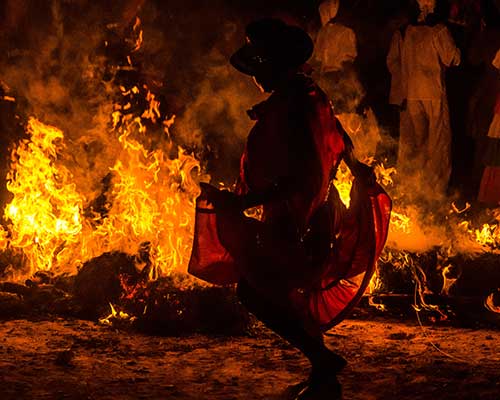
Cuba Fire Festival
Organized by Casa del Caribe, the annual Cuba Fire Festival will take place in Santiago de Cuba from July 2, 2026 to July 9, 2026. With musical venues at 50 locations and city streets lined with bars and stalls, rum-fuelled revellers get in the festival spirit as live bands, musicians and DJs keep crowds at fever pitch well into the nighttime hours.
Book NowCuba Fire Festival
Organized by Casa del Caribe, the annual Cuba Fire Festival will take place in Santiago de Cuba from July 2, 2026 to July 9, 2026. With musical venues at 50 locations and city streets lined with bars and stalls, rum-fuelled revellers get in the festival spirit as live bands, musicians and DJs keep crowds at fever pitch well into the nighttime hours.
Book Now
Havana Film Festival
The Havana Film Festival promotes the cinematographic works of Spanish- language filmmakers from Latin America, Spain and Cuba. It is sponsored by the Cuban Institute of the Cinematographic Art and Industry, ICAIC. The 46th edition of the Festival International del Nuevo Cine Latinoamericano will take place from December 4, 2025 to December 14, 2025.
Book NowHavana Film Festival
The Havana Film Festival promotes the cinematographic works of Spanish- language filmmakers from Latin America, Spain and Cuba. It is sponsored by the Cuban Institute of the Cinematographic Art and Industry, ICAIC. The 46th edition of the Festival International del Nuevo Cine Latinoamericano will take place from December 4, 2025 to December 14, 2025.
Book Now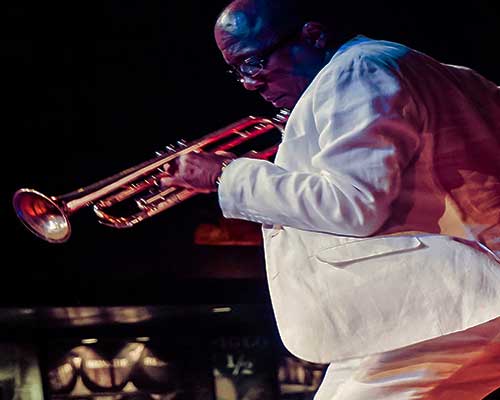
Havana Jazz Festival
The 41st International Jazz Festival of Havana, which is sponsored by famed Cuban jazz artist Chucho Valdes and ICM, or the Cuban Institute of Music, will be held in numerous locations throughout La Habana from January 25, 2026 to February 1, 2026. More than 100 international bands have joined Cuba’s top Jazz musicians in previous festivals.
Book NowHavana Jazz Festival
The 41st International Jazz Festival of Havana, which is sponsored by famed Cuban jazz artist Chucho Valdes and ICM, or the Cuban Institute of Music, will be held in numerous locations throughout La Habana from January 25, 2026 to February 1, 2026. More than 100 international bands have joined Cuba’s top Jazz musicians in previous festivals.
Book Now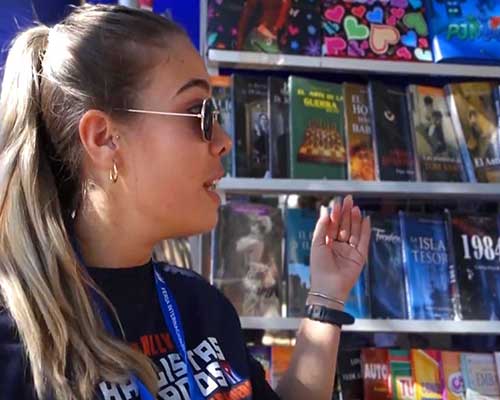
Havana Book Fair
The 34th International Book Fair of Havana will take place in Havana City from February 12 to February 22, 2026. Along with the public, the book fair is attended by Cuban and international authors, publishers, and political officials. Organized by the Cuban Book Institute, the fair transforms the Spanish fortification La Cabana into one of the biggest book parties in the world.
Book NowHavana Book Fair
The 34th International Book Fair of Havana will take place in Havana City from February 12 to February 22, 2026. Along with the public, the book fair is attended by Cuban and international authors, publishers, and political officials. Organized by the Cuban Book Institute, the fair transforms the Spanish fortification La Cabana into one of the biggest book parties in the world.
Book Now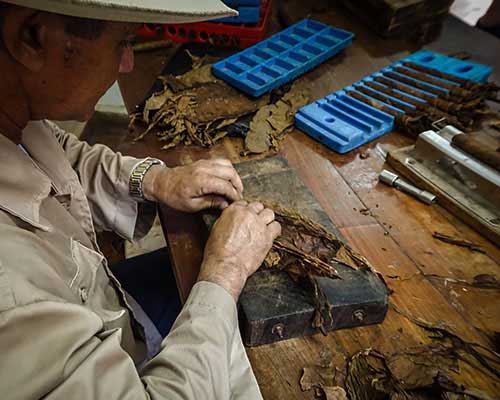
Habano Cigar Festival
Considered by many to be the world’s biggest premium cigar celebration, the XXVI Cigar Festival of Cuba will take place from February 23 to February 27, 2026. The Habano Cigar Festival's Exhibit Fair at Palacio de Las Convenciones regularly attracts some 1500 producers, distributors and businessmen, as well as large numbers of Cigar aficionados and tourists.
Book NowHabano Cigar Festival
Considered by many to be the world’s biggest premium cigar celebration, the XXVI Cigar Festival of Cuba will take place from February 23 to February 27, 2026. The Habano Cigar Festival's Exhibit Fair at Palacio de Las Convenciones regularly attracts some 1500 producers, distributors and businessmen, as well as large numbers of Cigar aficionados and tourists.
Book Now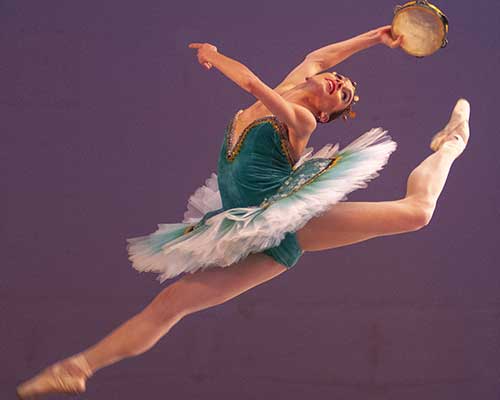
Havana Ballet Festival
The 29th Anniversary of the International Ballet Festival of Havana Alicia Alonso will take place from October 28 to November 6, 2026. Dancers, ballet companies, and choreographers from across the world look forward to the event, which is hosted by Cuba’s National Ballet at the Great Theatre of Havana, the Karl Marx Theatre and the Mella Theatre.
Book NowHavana Ballet Festival
The 29th Anniversary of the International Ballet Festival of Havana Alicia Alonso will take place from October 28 to November 6, 2026. Dancers, ballet companies, and choreographers from across the world look forward to the event, which is hosted by Cuba’s National Ballet at the Great Theatre of Havana, the Karl Marx Theatre and the Mella Theatre.
Book Now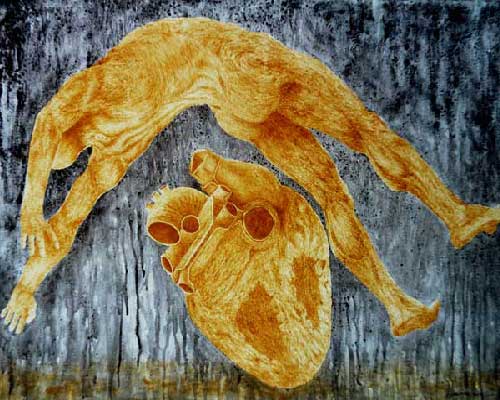
Havana Art Biennial
The 16th Havana Art Biennial will take place from November 15, 2027 to February 28, 2028. The rooster of international and national visual artists will include more than 200 creators from about 20 countries. According to the Wifredo Lam Art Center (organizing institution), the festival will turn the city into an interactive cultural corridor between the creators and public.
Book NowHavana Art Biennial
The 16th Havana Art Biennial will take place from November 15, 2027 to February 28, 2028. The rooster of international and national visual artists will include more than 200 creators from about 20 countries. According to the Wifredo Lam Art Center (organizing institution), the festival will turn the city into an interactive cultural corridor between the creators and public.
Book Now
Art & Fashion Festival
The 22nd Edition of the Arte y Moda Festival will take place in the Cuban capital from November 6 to 8, 2026. The event showcases the creativity and innovation of Cuban designers, particularly their emphasis on sustainability through the use of natural and recycled materials. They utilize innovative textiles, focusing on experimental and forward looking fashion.
Book NowArt & Fashion Festival
The 22nd Edition of the Arte y Moda Festival will take place in the Cuban capital from November 6 to 8, 2026. The event showcases the creativity and innovation of Cuban designers, particularly their emphasis on sustainability through the use of natural and recycled materials. They utilize innovative textiles, focusing on experimental and forward looking fashion.
Book Now







CUBA TOUR FINDER
Select your authentic Cuba trip from over 70 Cuba tours in seconds. Sort by departure date, price, destination and even Cuba travel theme.
QUICK CUBA TOUR FINDERCuba Themed Tours
If you’ve got an idea of which style of trip will suit you best, take a look at our different trip themes below, as there’s something to suit everyone. Not only are there themed tours to fit any budget and interest, each Authentic Cuba Travel® experience immerses you in the authentic Cuba so hard to explore while just staying in full packed beach resorts.
Festival Tours
Our festival tours give travelers VIP access to all venues and happenings of Cuba’s famous international events such as the Havana Jazz Festival, Book Fair, Ballet Festival and others.
Study Tours
Through peer to peer interaction, our Cuba Study Tours® transcend ordinary tourism by immersing American students in the local culture, history, politics, music and contemporary arts.
Cultural Tours
Cuba Pathfinder® is your gateway to discover the unique Cuban cultural heritage, a set of traditions & memories not showcased in museums but much alive & thriving.
Architecture Tours
An architectural passage through Cuba’s best preserved colonial cities and unique architectural heritage, our architecture tours visit all UNESCO World Heritage Sites in Cuba.
Photography Tours
Capturing stirring pictures of authentic Cuban destinations it is not the only mission of our photography tours. Capture the essence of the Cuban culture and the kindness of its people.
Educational Tours
Our educational tours represents a great opportunity for K-12 teachers, university & college professors to explore Cuba’s education system while exploring colonial cities, towns and villages.
Nature Tours
An odyssey into Cuba's tropical paradise, our nature & bird watching tours gain access to the most pristine natural sites, from UNESCO Biosphere Reserves to National Parks.
Jewish Tours
A journey into the Jewish history in Cuba, our tours will strengthen the ties between Cuban Jewish communities and North American Jews. All while visiting 4 UNESCO World Heritage Sites!
Sports Tours
What sets our sports tours apart are the private exchanges with players, coaches & staff as well as sports journalists & personalities. Then you have best seats at the games!
List of Cuba Tours 2026
-
Tour Name
Tour Dates
Cost
-
Havana Film Festival
Havana, Vinales
Dec 8- Dec 15, 2025
$2,899 Book Now
-
Real Cuba Tour 12
Havana, Las Terrazas, Vinales
Dec 26- Jan 2, 2026
$2,799 Book Now
-
Cuba Engage Tour 12
Havana, Bay of Pigs, Trinidad
Dec 26- Jan 2, 2026
$2,799 Book Now
-
Cuba Education Tour 9
Havana, Cienfuegos, Trinidad
Dec 26- Jan 2, 2026
$2,599 Book Now
-
Cuba Education Tour 10
Havana, Bay of Pigs, Santa Clara
Dec 26- Jan 2, 2026
$2,599 Book Now
-
Cuba Education Tour 11
Havana, Santiago de Cuba
Dec 26- Jan 2, 2026
$2,799 Book Now
-
Bird Watching Tour
Havana, Zapata, Trinidad
Dec 26- Jan 2, 2026
$2,599 Book Now
-
Cuba Architecture II
Havana, Cienfuegos, Trinidad
Dec 26- Jan 2, 2026
$2,799 Book Now
-
Cuba Art Explorer IV
Havana, Las Terrazas
Dec 26- Jan 2, 2026
$2,799 Book Now
-
Photography Tour IV
Havana, Vinales, Trinidad
Dec 26- Jan 2, 2026
$2,729 Book Now
-
Jewish Heritage Tour
Havana, Cienfuegos, Trinidad
Dec 26- Jan 2, 2026
$2,899 Book Now
-
Family Discovery Tour
Havana, Cienfuegos, Trinidad
Dec 26- Jan 2, 2026
$2,699 Book Now
-
Real Cuba Tour 1
Havana, Las Terrazas, Vinales
Jan 10- Jan 17, 2026
$2,599 Book Now
-
Cuba Engage Tour 1
Havana, Bay of Pigs, Trinidad
Jan 10- Jan 17, 2026
$2,599 Book Now
-
Cuba Jazz Festival
Havana, Cienfuegos, Trinidad
Jan 25- Feb 2, 2026
$3,099 Book Now
-
Santiago Jazz Festival
Santiago de Cuba
Jan 25- Feb 1, 2026
$2,899 Book Now
-
Havana Jazz Festival
Havana, Vinales
Jan 28- Feb 2, 2026
$2,499 Book Now
-
Havana Book Fair
Havana, Cienfuegos, Trinidad
Feb 13- Feb 20, 2026
$2,799 Book Now
-
Real Cuba Tour 2
Havana, Las Terrazas, Vinales
Feb 7- Feb 14, 2026
$2,599 Book Now
-
Cuba Engage Tour 2
Havana, Bay of Pigs, Trinidad
Feb 7- Feb 14, 2026
$2,599 Book Now
-
Habano Cigar Festival
Havana, Vinales
Feb 21- Feb 28, 2026
$8,999 Book Now
-
Cuba Education Tour 1
Havana, Cienfuegos, Trinidad
Feb 21- Feb 28, 2026
$2,599 Book Now
-
Cuba Education Tour 2
Havana, Cienfuegos, Trinidad
Feb 28- Mar 7, 2026
$2,599 Book Now
-
Cuba Al Natural
Havana, Zapata, Trinidad
Mar 7- Mar 18, 2026
$2,859 Book Now
-
Cuba Business Tour 1
Havana, Matanzas, Varadero
Mar 7- Mar 14, 2026
$2,599 Book Now
-
Healthcare Cuba Tour 1
Havana, Cienfuegos, Trinidad
Mar 7- Mar 14, 2026
$2,599 Book Now
-
Real Cuba Tour 3
Havana, Las Terrazas, Vinales
Mar 7- Mar 14, 2026
$2,599 Book Now
-
Cuba Engage Tour 3
Havana, Bay of Pigs, Trinidad
Mar 7- Mar 14, 2026
$2,599 Book Now
-
Cuba Art Explorer I
Havana, Vinales
Mar 7- Mar 14, 2026
$2,599 Book Now
-
Bird Watching Tour
Havana, Zapata, Trinidad
Mar 7- Mar 14, 2026
$2,599 Book Now
-
Cuba Education Tour 3
Havana, Cienfuegos, Trinidad
Mar 7- Mar 14, 2026
$2,599 Book Now
-
Cuba Education Tour 4
Havana, Vinales
Mar 14- Mar 21, 2026
$2,599 Book Now
-
Photography Tour I
Havana, Vinales, Trinidad
Apr 4- Apr 11, 2026
$2,629 Book Now
-
The Nature of Cuba
Havana, Vinales, Trinidad
Apr 4- Apr 13, 2026
$2,799 Book Now
-
Real Cuba Tour 4
Havana, Las Terrazas, Vinales
Apr 4- Apr 11, 2026
$2,599 Book Now
-
Cuba Engage Tour 4
Havana, Bay of Pigs, Trinidad
Apr 4- Apr 11, 2026
$2,599 Book Now
-
4 Biosphere Reserves
Rosario, Zapata, Buenavista
May 1- May 10, 2026
$2,999 Book Now
-
Real Cuba Tour 5
Havana, Las Terrazas, Vinales
May 9- May 16, 2026
$2,599 Book Now
-
Cuba Engage Tour 5
Havana, Bay of Pigs, Trinidad
May 9- May 16, 2026
$2,599 Book Now
-
Photography Tour II
Havana, Vinales, Trinidad
Jun 6- Jun 13, 2026
$2,629 Book Now
-
Cuba Art Explorer II
Havana, Cienfuegos, Trinidad
Jun 6- Jun 13, 2026
$2,599 Book Now
-
Cuba Education Tour 5
Havana, Cienfuegos, Trinidad
Jun 6- Jun 13, 2026
$2,599 Book Now
-
Real Cuba Tour 6
Havana, Las Terrazas, Vinales
Jun 6- Jun 13, 2026
$2,599 Book Now
-
Cuba Engage Tour 6
Havana, Bay of Pigs, Trinidad
Jun 6- Jun 13, 2026
$2,599 Book Now
-
Cuba Fire Festival
Havana, Santiago de Cuba
Jul 2- Jul 9, 2026
$2,799 Book Now
-
Real Cuba Tour 7
Havana, Las Terrazas, Vinales
Jul 4- Jul 11, 2026
$2,599 Book Now
-
Cuba Engage Tour 7
Havana, Bay of Pigs, Trinidad
Jul 4- Jul 11, 2026
$2,599 Book Now
-
Cuba Business Tour 2
Havana, Matanzas, Varadero
Jul 4- Jul 11, 2026
$2,599 Book Now
-
Healthcare Cuba Tour 2
Havana, Cienfuegos, Trinidad
Jul 4- Jul 11, 2026
$2,599 Book Now
-
Cuba Education Tour 6
Havana, Santiago de Cuba
Jul 4- Jul 11, 2026
$2,799 Book Now
-
Cuba Education Tour 7
Havana, Las Terrazas & Vinales
Jul 11- Jul 18, 2026
$2,599 Book Now
-
Jews of Cuba Travel
Havana, Santa Clara, Cienfuegos
Aug 6- Aug 13, 2026
$2,799 Book Now
-
Real Cuba Tour 8
Havana, Las Terrazas, Vinales
Aug 8- Aug 15, 2026
$2,599 Book Now
-
Cuba Engage Tour 8
Havana, Bay of Pigs, Trinidad
Aug 8- Aug 15, 2026
$2,599 Book Now
-
Photography Tour III
Havana, Vinales, Trinidad
Aug 8- Aug 15, 2026
$2,629 Book Now
-
Cuba Education Tour 8
Havana, Cienfuegos, Trinidad
Aug 8- Aug 15, 2026
$2,599 Book Now
-
Cuba Art Explorer III
Havana, Vinales
Aug 8- Aug 15, 2026
$2,599 Book Now
-
Cuba Legal Travel
Havana, Vinales
Aug 8- Aug 15, 2026
$2,799 Book Now
-
Cuba Architecture I
Havana, Cienfuegos, Trinidad
Aug 8- Aug 15, 2026
$2,599 Book Now
-
Seven Cities II
Havana, Santiago de Cuba
Aug 8- Aug 19, 2026
$3,329 Book Now
-
Real Cuba Tour 9
Havana, Las Terrazas, Vinales
Sep 5- Sep 12, 2026
$2,599 Book Now
-
Cuba Engage Tour 9
Havana, Bay of Pigs, Trinidad
Sep 5- Sep 12, 2026
$2,599 Book Now
-
Baseball Tour
Havana, Cienfuegos, Trinidad
Sep 5- Sep 12, 2026
$2,999 Book Now
-
African Heritage
Havana, Las Terrazas, Vinales
Oct 3- Oct 9, 2026
$2,699 Book Now
-
Real Cuba Tour 10
Havana, Las Terrazas, Vinales
Oct 3- Oct 10, 2026
$2,599 Book Now
-
Cuba Engage Tour 10
Havana, Bay of Pigs, Trinidad
Oct 3- Oct 10, 2026
$2,599 Book Now
-
Dance Cuba Tour
Havana, Las Terrazas
Oct 3- Oct 10, 2026
$2,599 Book Now
-
Performing Arts Tour
Havana, Cienfuegos, Trinidad
Oct 3- Oct 10, 2026
$2,599 Book Now
-
Cuba Ballet Festival
Havana, Vinales
Oct 31- Nov 7, 2026
$2,999 Book Now
-
Jo Jazz Havana
Havana, Las Terrazas, Vinales
Nov 4- Nov 11, 2026
$2,799 Book Now
-
Seven Cities I
Havana, Santiago de Cuba
Nov 5- Nov 16, 2026
$3,329 Book Now
-
Cuba Nature Tour
Havana, Vinales, Trinidad
Nov 6- Nov 15, 2026
$2,799 Book Now
-
Art & Fashion Festival
Havana, Cienfuegos, Trinidad
Nov 6- Nov 13, 2026
$2,699 Book Now
-
Real Cuba Tour 11
Havana, Las Terrazas, Vinales
Nov 7- Nov 14, 2026
$2,599 Book Now
-
Cuba Engage Tour 11
Havana, Bay of Pigs, Trinidad
Nov 7- Nov 14, 2026
$2,599 Book Now
-
Cuba Business Tour 3
Havana, Matanzas, Varadero
Nov 7- Nov 14, 2026
$2,599 Book Now
-
Healthcare Cuba Tour 3
Havana, Cienfuegos, Trinidad
Nov 7- Nov 14, 2026
$2,599 Book Now
-
Havana Art Biennial
Havana, Vinales
Dec 11- Dec 18, 2027
$2,799 Book Now
SUBSCRIBE
Sign Up to Authentic Cuba Travel® Newsletter and be well informed on Cuba Nature Tours and Bird Watching Tour Expeditions to Cuba. Our monthly newsletter is the best way to stay in touch with the latest authentic Cuba tour additions and receive updated alerts when our nature & birding tours are almost filled to capacity, giving you the chance to book before we make the general announcement to the world of Cuba nature and birdwatching travellers out there.
NewsletterMemberships & Affiliations
Bella Travel Group Ltd. (Federal Corporation number: 765324-7) owns and operates the following registered trademarks: Authentic Cuba Travel® is a trademark registered at the Canadian Intellectual Property Office (CIPO), Registration No. TMA975677 | Cuba Pathfinder® is a trademark registered at the Canadian Intellectual Property Office (CIPO), Registration No. TMA997988 | Cuba Pathfinder® is a trademark registered at the United States Patent and Trademark Office (USPTO), Registration No. 5498353 | Cuba Study Tours, Make Cuba Your Classroom® is a trademark registered at the United States Patent and Trademark Office (USPTO), Registration No. 5833051.

 1-877-280-2054 (North America)
1-877-280-2054 (North America) 647-351-8191
(Worldwide)
647-351-8191
(Worldwide)
 647-351-8191
(Worldwide)
647-351-8191
(Worldwide)


